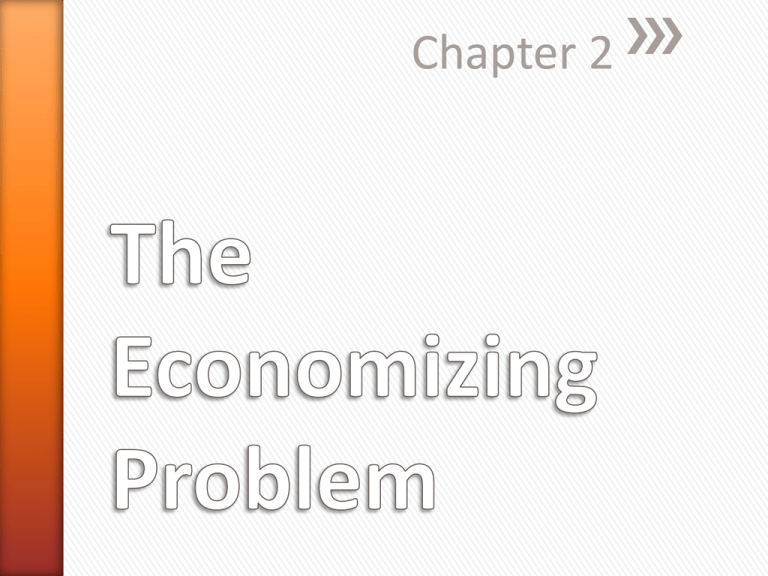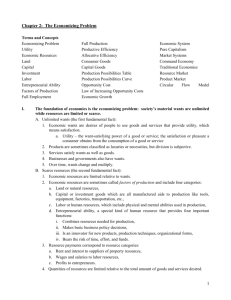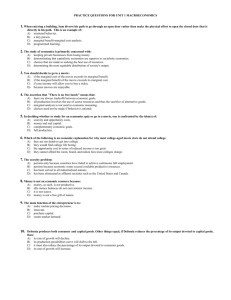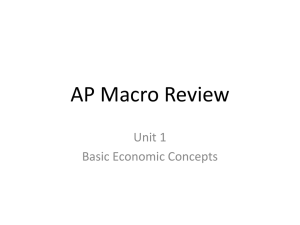The Economizing Problem
advertisement

Chapter 2 » After completing this chapter, students should be able to: ˃ Define the economizing problem, incorporating the relationship between limited resources and unlimited wants. ˃ Identify types of economic resources and types of income associated with various factors. ˃ Differentiate between full employment and full production. ˃ Explain the concepts of allocative and productive efficiency and how they differ. ˃ Construct a production possibilities curve when given appropriate data. ˃ Illustrate economic growth, unemployment and underemployment of resources, allocative and productive efficiency, and increasing costs using a production possibilities curve. ˃ Give examples of underallocation and overallocation of resources. ˃ Give some real-world applications of the production possibilities concept. ˃ Summarize the general relationship between investment and economic growth. ˃ Highlight the main features of a market economy and a command economy. ˃ Identify the decision makers and the markets in a market system using the circular flow diagram. ˃ Identify the two roles each that households and businesses play using the circular flow diagram. ˃ Differentiate between product and resource markets. ˃ Define and identify the terms and concepts listed at the end of the chapter. » A. Unlimited wants (the first fundamental fact): ˃ 1. Economic wants are desires of people to use goods and services that provide utility, which means satisfaction. ˃ 2. Products are sometimes classified as luxuries or necessities, but division is subjective. ˃ 3. Services satisfy wants as well as goods. ˃ 4. Businesses and governments also have wants. ˃ 5. Over time, wants change and multiply. » B. Scarce resources (the second fundamental fact): ˃ 1.Economic resources are limited relative to wants. ˃ 2.Economic resources are sometimes called factors of production and include four categories: + a. Land or natural resources, + b. Capital or investment goods which are all manufactured aids to production like tools, equipment, factories, transportation, etc., + c. Labor or human resources, which include physical and mental abilities used in production, + d. Entrepreneurial ability, a special kind of human resource that provides four important functions: – i. Combines resources needed for production, + ii. Makes basic business policy decisions, + iii. Is an innovator for new products, production techniques, organizational forms, + iv. Bears the risk of time, effort, and funds. ˃ 3.Resource payments correspond to resource categories: + a. Rent and interest to suppliers of property resources, + b. Wages and salaries to labor resources, + c. Profits to entrepreneurs. ˃ 4.Quantities of resources are limited relative to the total amount of goods and services desired. » A. Basic definition: Economics is the social science concerned with the problem of using scarce resources to attain the greatest fulfillment of society’s unlimited wants. » B. Economics is a science of efficiency in the use of scarce resources. Efficiency requires full employment of available resources and full production. ˃ 1. Full employment means all available resources should be employed. ˃ 2. Full production means that employed resources are providing maximum satisfaction of our economic wants. Underemployment occurs if this is not so. » C. Full production implies two kinds of efficiency: ˃ 1. Allocative efficiency means that resources are used for producing the combination of goods and services most wanted by society—for example, producing compact discs instead of long-playing records with productive resources or computers with word processors rather than manual typewriters. ˃ 2. Productive efficiency means that least costly production techniques are used to produce wanted goods and services. » D. Full production means producing the “right” goods (allocative efficiency) in the “right” way (productive efficiency). (Key Question 5) » A. Assumptions: ˃ ˃ ˃ ˃ 1. Economy is operating efficiently (full employment and full production). 2. Available supply of resources is fixed in quantity and quality at this point in time. 3. Technology is constant during analysis. 4. Economy produces only two types of products. » B. Choices will be necessary because resources and technology are fixed. A production possibilities table illustrates some of the possible choices (see Table 2-1). » C. A production possibilities curve is a graphical representation of choices. ˃ 1. Points on the curve represent maximum possible combinations of robots and pizza given resources and technology. ˃ 2. Points inside the curve represent underemployment or unemployment. ˃ 3. Points outside the curve are unattainable at present. » D. Optimal or best product-mix: ˃ 1. It will be some point on the curve. ˃ 2. The exact point depends on society; this is a normative decision. » E. Law of increasing opportunity costs: ˃ 1. The amount of other products that must be foregone to obtain more of any given product is called the opportunity cost. ˃ 2. Opportunity costs are measured in real terms rather than money (market prices are not part of the production possibilities model.) ˃ 3. The more of a product produced the greater is its (marginal) opportunity cost. ˃ 4. The slope of the production possibilities curve becomes steeper, demonstrating increasing opportunity cost. This makes the curve appear bowed out, concave from the origin. ˃ 5. Economic Rationale: + a. Economic resources are not completely adaptable to alternative uses. + b. To get increasing amounts of pizza, resources that are not particularly well suited for that purpose must be used. Workers that are accustomed to producing robots on an assembly line may not do well as kitchen help. » F. Allocative efficiency revisited: ˃ 1. How does society decide its optimal point on the production possibilities curve? ˃ 2. Recall that society receives marginal benefits from each additional product consumed, and as long as this marginal benefit is more than the additional cost of the product, it is advantageous to have the additional product. ˃ 3. Conversely, if the additional (marginal) cost of obtaining an additional product is more than the additional benefit received, then it is not “worth” it to society to produce the extra unit. ˃ 4. Figure 2-2 reminds us that marginal costs rise as more of a product is produced. ˃ 5. Marginal benefits decline as society consumes more and more pizzas. In Figure 2-2 we can see that the optimal amount of pizza is 200,000 units, where marginal benefit just covers marginal cost. + a. Beyond that, the added benefits would be less than the added cost. + b. At less than 200,000, the added benefits will exceed the added costs, so it makes sense to produce more. ˃ 6. Generalization: The optimal production of any item is where its marginal benefit is equal to its marginal cost. In our example, for robots this must occur at 7,000 robots. » A. Unemployment and productive inefficiency occur when the economy is producing less than full production or inside the curve (point U in Figure 2-3). » B. In a growing economy, the production possibilities curve shifts outward. ˃ 1. When resource supplies expand in quantity or quality. ˃ 2. When technological advances are occurring. » C. Present choices and future possibilities: Using resources to produce consumer goods and services represents a choice for present over future consumption. Using resources to invest in technological advance, education, and capital goods represents a choice for future over present goods. The decision as to how to allocate resources in the present will create more or less economic growth in the future. (Key Questions 10 and 11) » (See for example Global Perspective 2-1 where various countries are compared with respect to their economic growth rates relative to the share of GDP devoted to investment.) » D. A Qualification: International Trade ˃ 1. A nation can avoid the output limits of its domestic Production Possibilities through international specialization and trade. ˃ 2. Specialization and trade have the same effect as having more and better resources of improved technology. » E. Examples and Applications ˃ 1. Unemployment and Productive Inefficiency: + a. Depression + b. Discrimination in the labor market. ˃ 2. Tradeoffs and Opportunity Costs + a. Logging and mining versus wilderness. + b. Allocation of tax resources. ˃ 3. Shifts of Production Possibilities Curve + a. Technological advances in the U.S. + b. The effects of war. » H. See the Last Word on how a large increase in the number of women in the labor force has shifted the production possibilities curve outward. » A. The market system: ˃ ˃ ˃ ˃ ˃ 1. There is private ownership of resources. 2. Markets and prices coordinate and direct economic activity. 3. Each participant acts in his or her own self-interest. 4. In pure capitalism the government plays a very limited role. 5. In the U.S. version of capitalism, the government plays a substantial role. » B. Command economy, socialism or communism: ˃ 1. There is public (state) ownership of resources. ˃ 2. Economic activity is coordinated by central planning. » A. There are two groups of decision makers in private economy (no government yet): households and businesses. ˃ 1. The market system coordinates these decisions. ˃ 2. What happens in the resource markets? + a. Households sell resources directly or indirectly (through ownership of corporations). + b. Businesses buy resources in order to produce goods and services. + c. Interaction of these sellers and buyers determines the price of each resource, which in turn provides income for the owner of that resource. + d. Flow of payments from businesses for the resources constitutes business costs and resource owners’ incomes. ˃ 3. What happens in the product markets? + a. Households are on the buying side of these markets, purchasing goods and services. + b. Businesses are on the selling side of these markets, offering products for sale. + c. Interaction of these buyers and sellers determines the price of each product. + d. Flow of consumer expenditures constitutes sales receipts for businesses. ˃ 4. Circular flow model illustrates this complex web of decision-making and economic activity that give rise to the real and money flows. » B. Limitations of the model: ˃ 1. Does not depict transactions between households and between businesses. ˃ 2. Ignores government and the “rest of the world” in the decision-making process. ˃ 3. Does not explain how prices of products and resources are actually determined, but this is explained in Chapter 3. » A. There has been an increase in the number of women who are working. This has had the effect of shifting the production possibilities curve outward. » B. Whereas 40% of the women worked in 1965, 60% of the women are now working part time or full time. » C. There are a number of reasons for this change: ˃ ˃ ˃ ˃ ˃ ˃ 1. 2. 3. 4. 5. 6. An increase in women’s wage rates. Greater access to jobs. Changes in preferences and attitudes. Declining birthrates. Increasing divorce rates. Slower growth in male wages.








